Discover Florida Nature
It's time to explore the natural Florida


|
|
|
|
|
Florida Key Mole Skink
(Eumeces egregius egregius) SSC- The Florida key mole skink is only
found in the Florida Keys. Reaching 6" in length, it has a brown body,
eight yellow stripes, and a black-striped reddish tail. It can sometimes
be found under fallen fronds. Skinks tend to have smooth bodies, short
legs, and round tails. The Florida key mole skink is usually active
during the day. Their diet consists of insects. Mole skinks all burrow
underground in loose sand. Some lay their eggs as deep as six feet
underground. (picture unavailable)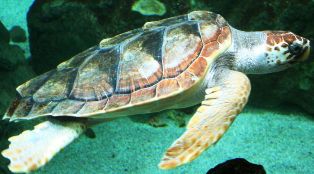 Loggerhead
Sea Turtle
(Caretta caretta) Threatened- The most common sea turtle in Loggerhead
Sea Turtle
(Caretta caretta) Threatened- The most common sea turtle in 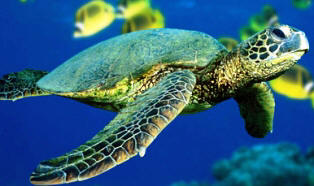 Green
Sea Turtle
(Chelonia mydas) Endangered- A more streamlined-looking turtle
than the bulky loggerhead, the green turtle weighs an average of 350
pounds and has a small head for its body size. Its oval-shaped upper
shell averages 3.3 feet in length and is olive-brown with darker streaks
running through it; its lower shell, or plastron, is yellow. Green
turtles are found during the day in shallow flats and seagrass meadows
and return every evening to their usual sleeping quarters—scattered rock
ledges, oyster bars, and coral reefs. Adult green turtles are unique
among sea turtles in that they are largely vegetarians, consuming
primarily seagrasses and algae. Approximately 100 to 1,000 green turtles
nest on Florida’s beaches each year from June through
late September. Green
Sea Turtle
(Chelonia mydas) Endangered- A more streamlined-looking turtle
than the bulky loggerhead, the green turtle weighs an average of 350
pounds and has a small head for its body size. Its oval-shaped upper
shell averages 3.3 feet in length and is olive-brown with darker streaks
running through it; its lower shell, or plastron, is yellow. Green
turtles are found during the day in shallow flats and seagrass meadows
and return every evening to their usual sleeping quarters—scattered rock
ledges, oyster bars, and coral reefs. Adult green turtles are unique
among sea turtles in that they are largely vegetarians, consuming
primarily seagrasses and algae. Approximately 100 to 1,000 green turtles
nest on Florida’s beaches each year from June through
late September.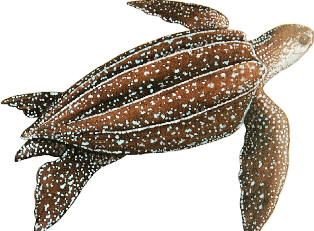 Leatherback
Sea Turtle
(Dermochelys coriacea) Endangered- Leatherbacks look distinctively
different from other sea turtles. Instead of a shell covered with scales
or shields, leatherbacks are covered with a firm, leathery skin and have
seven ridges running lengthwise down their backs. They are usually black
with white, pink, and blue splotches and have no claws on their
flippers. Leatherbacks eat soft-bodied animals such as jellyfish. The
leatherback is a fascinating and unique animal, even among sea turtles.
It is larger, dives deeper, travels farther, and tolerates colder waters
than any other sea turtle. Most leatherbacks average 6 feet in length
and weigh from 500 to 1,500 pounds, but the largest leatherback on
record was nearly 10 feet long and weighed more than 2,000 pounds. Leatherback
Sea Turtle
(Dermochelys coriacea) Endangered- Leatherbacks look distinctively
different from other sea turtles. Instead of a shell covered with scales
or shields, leatherbacks are covered with a firm, leathery skin and have
seven ridges running lengthwise down their backs. They are usually black
with white, pink, and blue splotches and have no claws on their
flippers. Leatherbacks eat soft-bodied animals such as jellyfish. The
leatherback is a fascinating and unique animal, even among sea turtles.
It is larger, dives deeper, travels farther, and tolerates colder waters
than any other sea turtle. Most leatherbacks average 6 feet in length
and weigh from 500 to 1,500 pounds, but the largest leatherback on
record was nearly 10 feet long and weighed more than 2,000 pounds.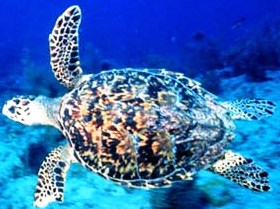 Hawksbill
Sea Turtle
(Eretmochelys imbricata) Endangered- The hawksbill is a small, agile
turtle whose beautiful tortoise-colored shell is its greatest liability.
The shell is still used in some European and Asian countries to make
jewelry, hair decorations and other ornaments, even though international
trade in hawksbill products has been banned in much of the world.
Hawksbills weigh from 100 to 200 pounds as adults and are approximately
30 inches in shell length. Its carapace is shaded with black and brown
markings on a background of amber. The shields of this kaleidoscopic
armor overlap, and the rear of the carapace is serrated. Its body is
oval-shaped, its head is narrow, and its raptor-like jaws give the
hawksbill its name. These jaws are perfectly adapted for collecting its
preferred food, sponges. They are frequently spotted by divers off the Hawksbill
Sea Turtle
(Eretmochelys imbricata) Endangered- The hawksbill is a small, agile
turtle whose beautiful tortoise-colored shell is its greatest liability.
The shell is still used in some European and Asian countries to make
jewelry, hair decorations and other ornaments, even though international
trade in hawksbill products has been banned in much of the world.
Hawksbills weigh from 100 to 200 pounds as adults and are approximately
30 inches in shell length. Its carapace is shaded with black and brown
markings on a background of amber. The shields of this kaleidoscopic
armor overlap, and the rear of the carapace is serrated. Its body is
oval-shaped, its head is narrow, and its raptor-like jaws give the
hawksbill its name. These jaws are perfectly adapted for collecting its
preferred food, sponges. They are frequently spotted by divers off the 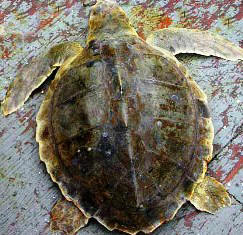 Kemp's
Ridley Sea Turtle
(Lepidochelys kempii) Endangered- The Kemp’s ridley is the
rarest sea turtle in the world and is the most endangered. It has only
one major nesting beach, an area called Rancho Nuevo on the Gulf coast
of Mexico. Fewer than 1,000 nesting females remain in the world.
Kemp’s ridleys are small, weighing only 85 to 100 pounds and measuring 2
to 2.5 feet in carapace length, but they are tough and tenacious. Their
principal diet is crabs and other crustaceans. Kemp's
Ridley Sea Turtle
(Lepidochelys kempii) Endangered- The Kemp’s ridley is the
rarest sea turtle in the world and is the most endangered. It has only
one major nesting beach, an area called Rancho Nuevo on the Gulf coast
of Mexico. Fewer than 1,000 nesting females remain in the world.
Kemp’s ridleys are small, weighing only 85 to 100 pounds and measuring 2
to 2.5 feet in carapace length, but they are tough and tenacious. Their
principal diet is crabs and other crustaceans.
|
|
|
Advertise | Privacy Statement | Dog Encyclopedia | Video |Contact | Alaska Nature |
|